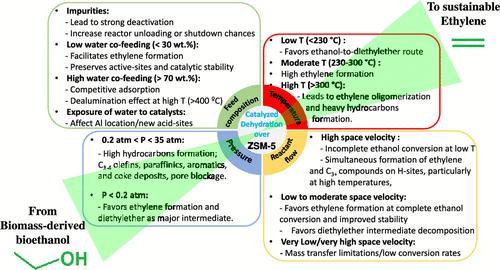当前位置:
X-MOL 学术
›
ACS Catal.
›
论文详情
Our official English website, www.x-mol.net, welcomes your
feedback! (Note: you will need to create a separate account there.)
Trend and Progress in Catalysis for Ethylene Production from Bioethanol Using ZSM-5
ACS Catalysis ( IF 11.3 ) Pub Date : 2024-11-11 , DOI: 10.1021/acscatal.4c04162 L. Ouayloul, I. Agirrezabal-Telleria, Paul Sebastien, M. El Doukkali
ACS Catalysis ( IF 11.3 ) Pub Date : 2024-11-11 , DOI: 10.1021/acscatal.4c04162 L. Ouayloul, I. Agirrezabal-Telleria, Paul Sebastien, M. El Doukkali

|
Advancing technologies for the conversion of bioethanol (ET) to ethylene (ETY) holds significant potential for enhancing the production of numerous tertiary chemicals, which are currently derived from fossil-based resources. This review explores the feasibility of producing ethylene from bioethanol and underscores its growing importance in the global market. It focuses on breakthroughs in ZSM-5-based catalysts, compared to conventional ones, with particular attention to two key aspects: (i) the remodulation of ZSM-5 properties to establish a clear catalyst structure–reactivity–selectivity relationship in ET conversion and (ii) the identification of major factors influencing ZSM-5 stability and reusability. State-of-the-art approaches for ZSM-5 modification and regeneration are thoroughly examined with an emphasis on the role of active sites in ETY formation. The impact of key reaction parameters (such as temperature, space velocity, pressure, and feed composition (including impurities and water)) on ET-to-ETY reaction kinetics is systematically evaluated. The review shows that the formation of undesirable C3+ hydrocarbons is promoted by the contribution of strong Brønsted acid sites at elevated temperatures. In contrast, pathways favoring the formation of ETY or diethyl ether (DEE) are driven by the individual or synergistic effects of weak Lewis and strong Brønsted acid sites at milder temperatures. The integration of ET-to-ETY conversion within compact biorefineries and polyolefin manufacturing chains, alongside in situ regeneration of ZSM-5 catalysts through controlled cofeeding of H2O at moderate temperatures, presents a promising strategy for intensifying the ET-to-ETY process. This Perspective expects to provide a comprehensive overview of recent developments in ET-to-ETY catalysis, particularly at lower temperatures, with the goal of improving process efficiency in terms of energy consumption, cost, and CO2 emissions.
中文翻译:

ZSM-5催化生物乙醇乙烯生产趋势与进展
推进生物乙醇 (ET) 转化为乙烯 (ETY) 的技术在提高许多三级化学品的生产方面具有巨大潜力,这些化学品目前来自化石资源。这篇综述探讨了从生物乙醇生产乙烯的可行性,并强调了其在全球市场上日益增长的重要性。与传统催化剂相比,它侧重于基于 ZSM-5 的催化剂的突破,特别关注两个关键方面:(i) ZSM-5 特性的再调节,以在 ET 转化中建立明确的催化剂结构-反应性-选择性关系,以及 (ii) 确定影响 ZSM-5 稳定性和可重用性的主要因素。彻底研究了 ZSM-5 修饰和再生的最新方法,重点是活性位点在 ETY 形成中的作用。系统评估了关键反应参数(如温度、空速、压力和进料成分(包括杂质和水))对 ET 到 ETY 反应动力学的影响。综述表明,在高温下,强 Brønsted 酸位点的贡献促进了不需要的 C3+ 碳氢化合物的形成。相比之下,在较温和的温度下,有利于形成 ETY 或乙醚 (DEE) 的途径是由弱 Lewis 和强 Brønsted 酸位点的单独或协同效应驱动的。在紧凑的生物精炼厂和聚烯烃制造链中整合 ET-ETY 转化,以及通过在中等温度下受控共喂 H2O 实现 ZSM-5 催化剂的原位再生,为强化 ET-ETY 工艺提供了一种很有前途的策略。 本观点旨在全面概述 ET-ETY 催化的最新发展,特别是在较低温度下,目标是提高能耗、成本和 CO2 排放方面的工艺效率。
更新日期:2024-11-12
中文翻译:

ZSM-5催化生物乙醇乙烯生产趋势与进展
推进生物乙醇 (ET) 转化为乙烯 (ETY) 的技术在提高许多三级化学品的生产方面具有巨大潜力,这些化学品目前来自化石资源。这篇综述探讨了从生物乙醇生产乙烯的可行性,并强调了其在全球市场上日益增长的重要性。与传统催化剂相比,它侧重于基于 ZSM-5 的催化剂的突破,特别关注两个关键方面:(i) ZSM-5 特性的再调节,以在 ET 转化中建立明确的催化剂结构-反应性-选择性关系,以及 (ii) 确定影响 ZSM-5 稳定性和可重用性的主要因素。彻底研究了 ZSM-5 修饰和再生的最新方法,重点是活性位点在 ETY 形成中的作用。系统评估了关键反应参数(如温度、空速、压力和进料成分(包括杂质和水))对 ET 到 ETY 反应动力学的影响。综述表明,在高温下,强 Brønsted 酸位点的贡献促进了不需要的 C3+ 碳氢化合物的形成。相比之下,在较温和的温度下,有利于形成 ETY 或乙醚 (DEE) 的途径是由弱 Lewis 和强 Brønsted 酸位点的单独或协同效应驱动的。在紧凑的生物精炼厂和聚烯烃制造链中整合 ET-ETY 转化,以及通过在中等温度下受控共喂 H2O 实现 ZSM-5 催化剂的原位再生,为强化 ET-ETY 工艺提供了一种很有前途的策略。 本观点旨在全面概述 ET-ETY 催化的最新发展,特别是在较低温度下,目标是提高能耗、成本和 CO2 排放方面的工艺效率。


















































 京公网安备 11010802027423号
京公网安备 11010802027423号